Abstract
Blue/green autofluorescence (excitation around 420 to 430 nm, emission around 520 nm) of the crystalline lens has been studied by an in vivo photographic method in two populations of diabetics and controls. The populations consisted of a geographically based survivor group of 161 mixed early and late onset diabetics (and 133 non-diabetic controls) and a second group of 104 early onset insulin dependent diabetics (and 138 non-diabetic controls), the latter all with non-cataractous lenses. Powerful associations (p less than 10(-6) were found between the presence of diabetes and increased lenticular autofluorescence in both populations. Among the mixed diabetics diabetic type was a significant factor after accounting for the effects of age and diabetic duration. In the early onset group (clear lenses) a powerful association existed between autofluorescence and diabetic duration (p = 0.000011) after allowing for the effect of age, while in a subgroup of late onset diabetics with clear lenses this effect was modest (p = 0.015). In the early onset diabetic group diabetic retinopathy (p = 0.0064) was associated with increased lenticular autofluorescence after allowing for the effects of age and diabetic duration. In addition a powerful interaction between diabetic duration and the presence of diabetic retinopathy (p less than 10(-6) was found in this subgroup. Among the geographically based population of diabetics, increased nuclear brunescence was powerfully associated (p less than 10(-6) with increased autofluorescence after allowing for the effects of age, diabetic duration, and type of diabetes. This association was not found in the non-diabetic population. Non-enzymatic glycosylation of lens proteins should be considered as a possible mechanism of production of the fluorogen with emission around 520 nm.
Full text
PDF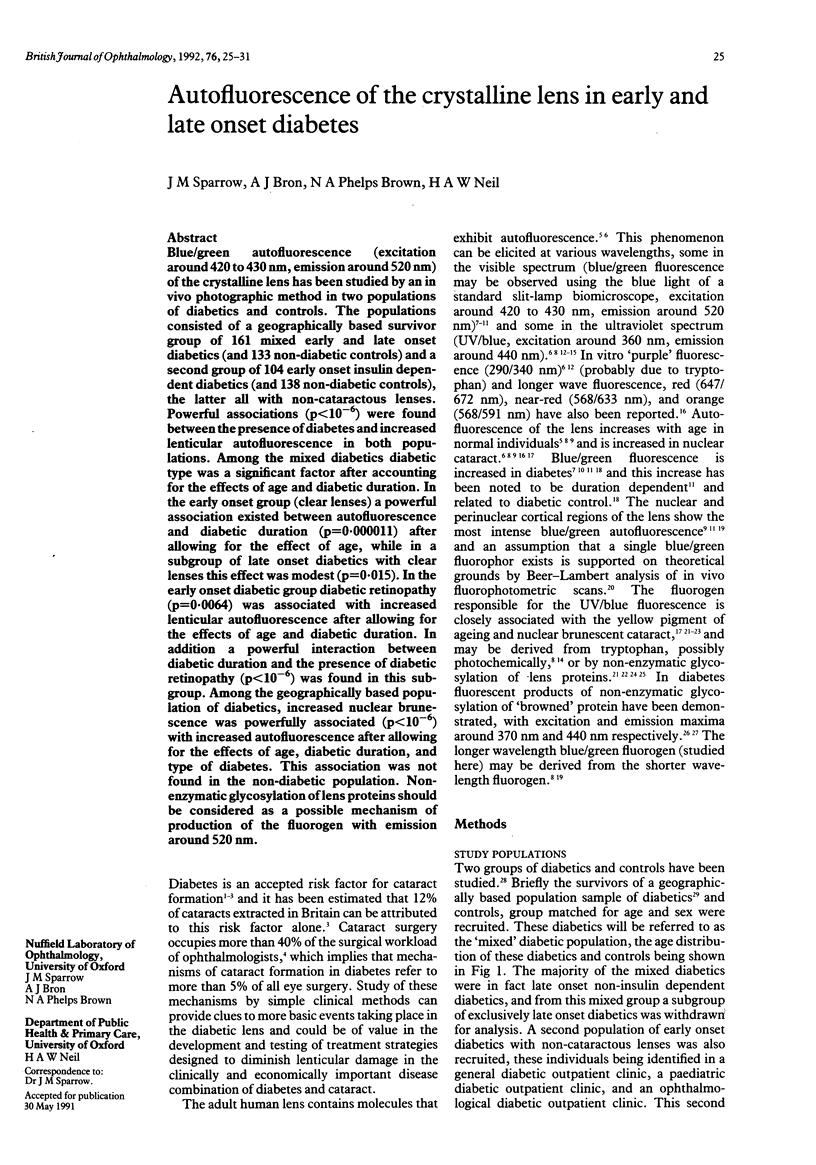
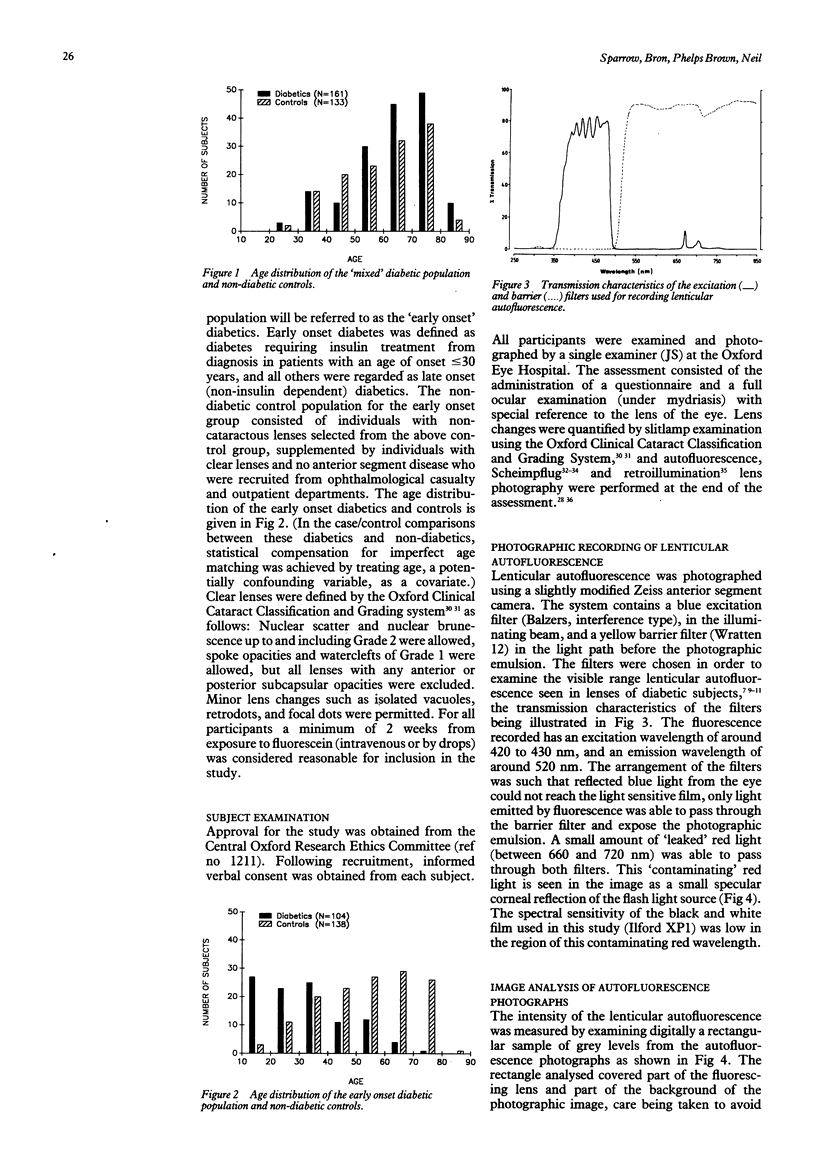
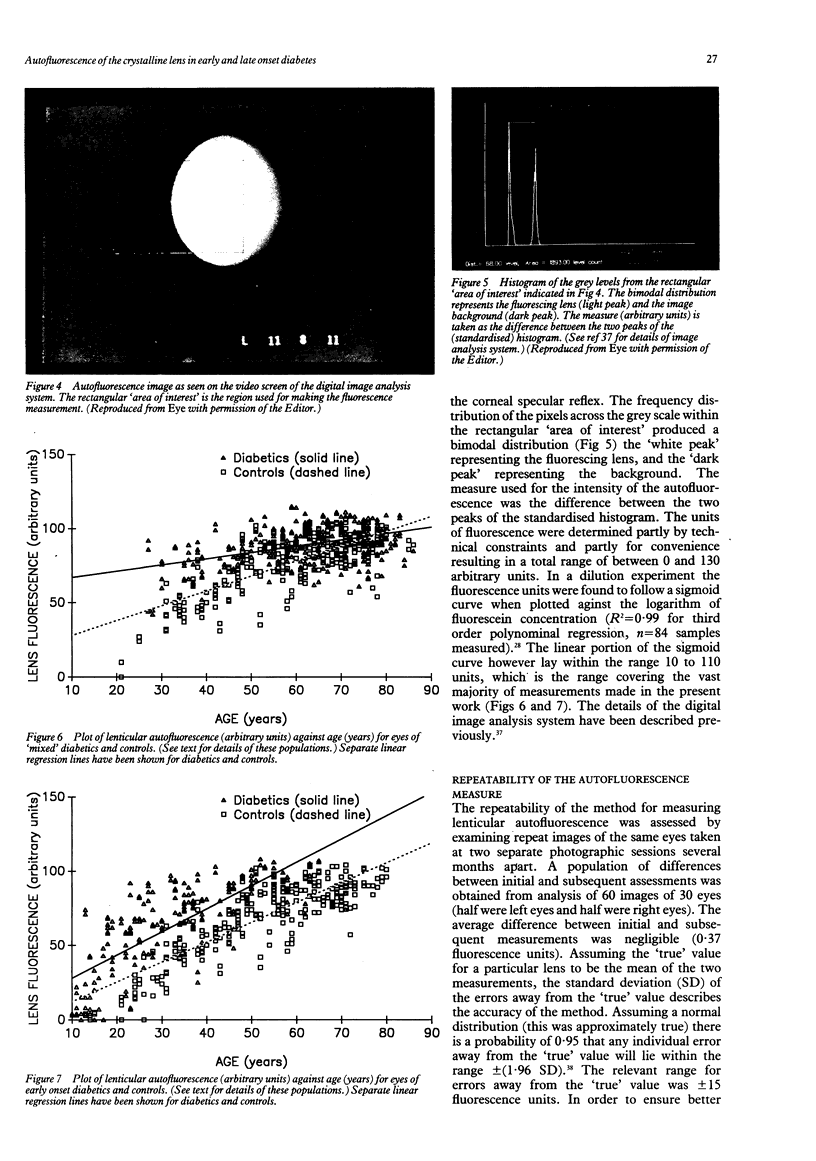
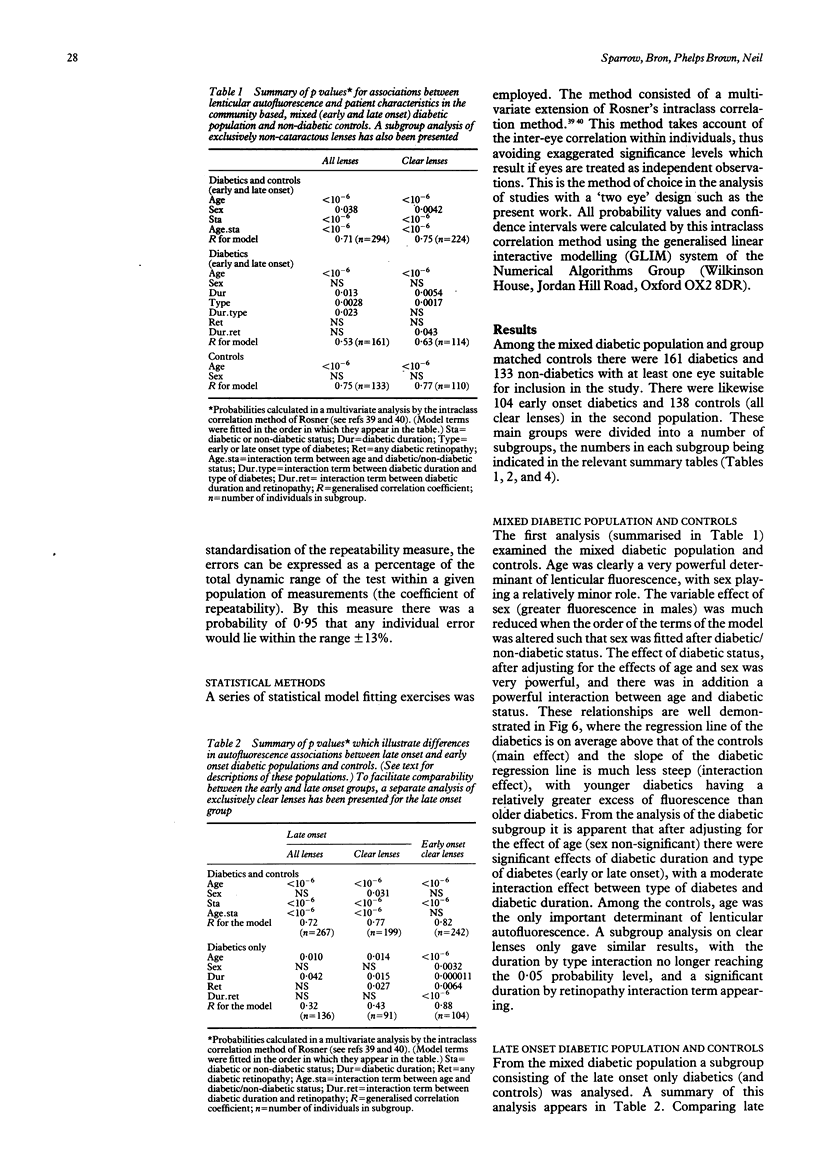
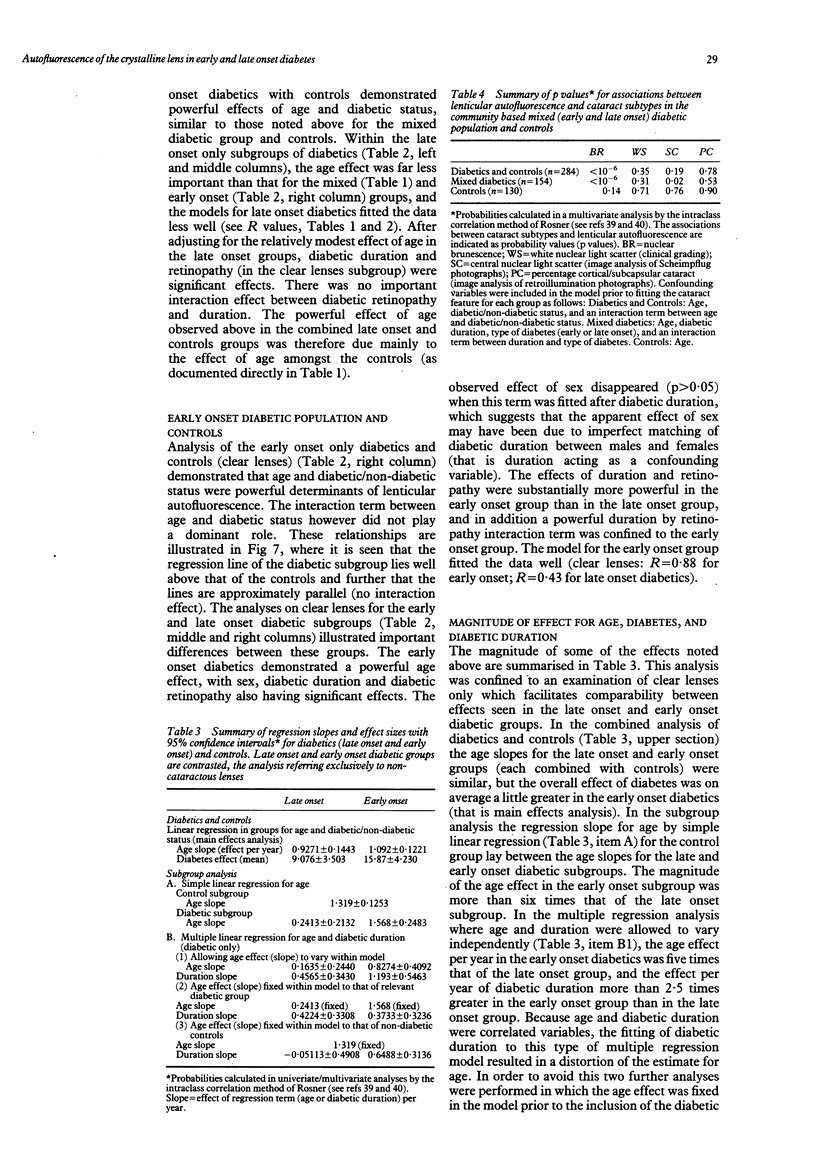
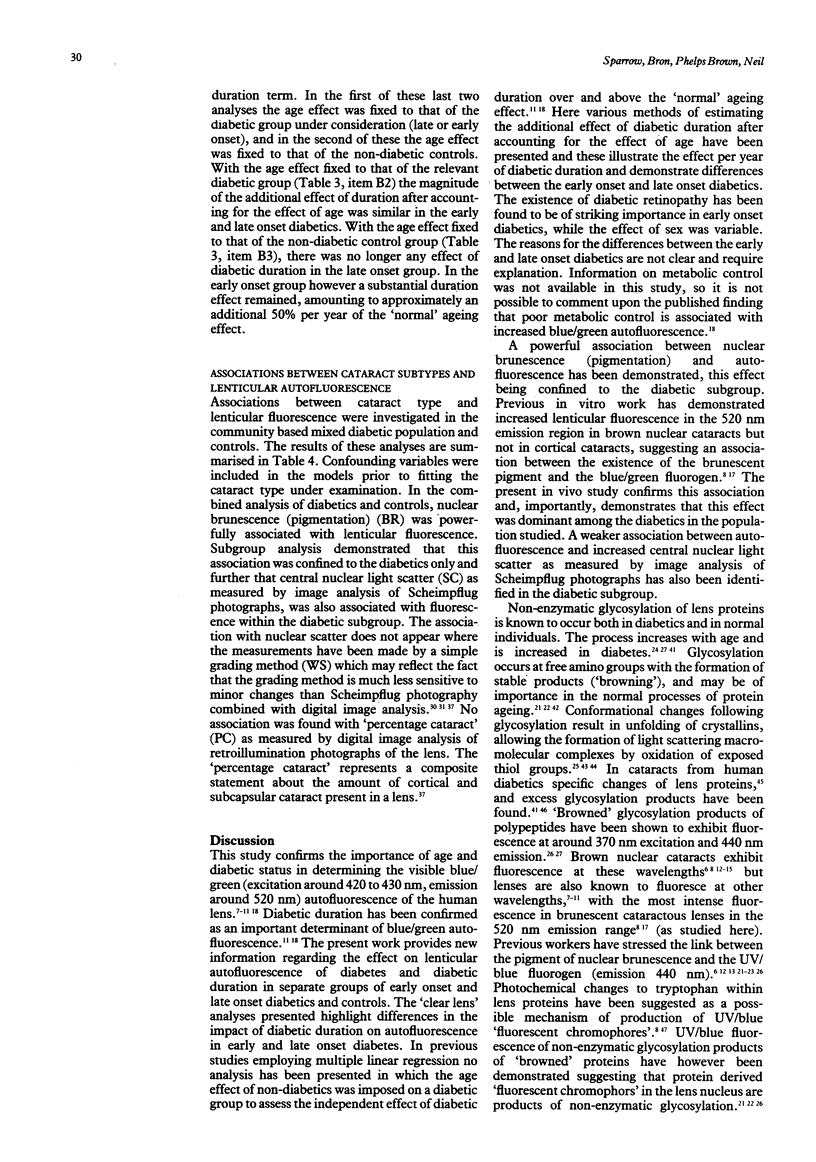
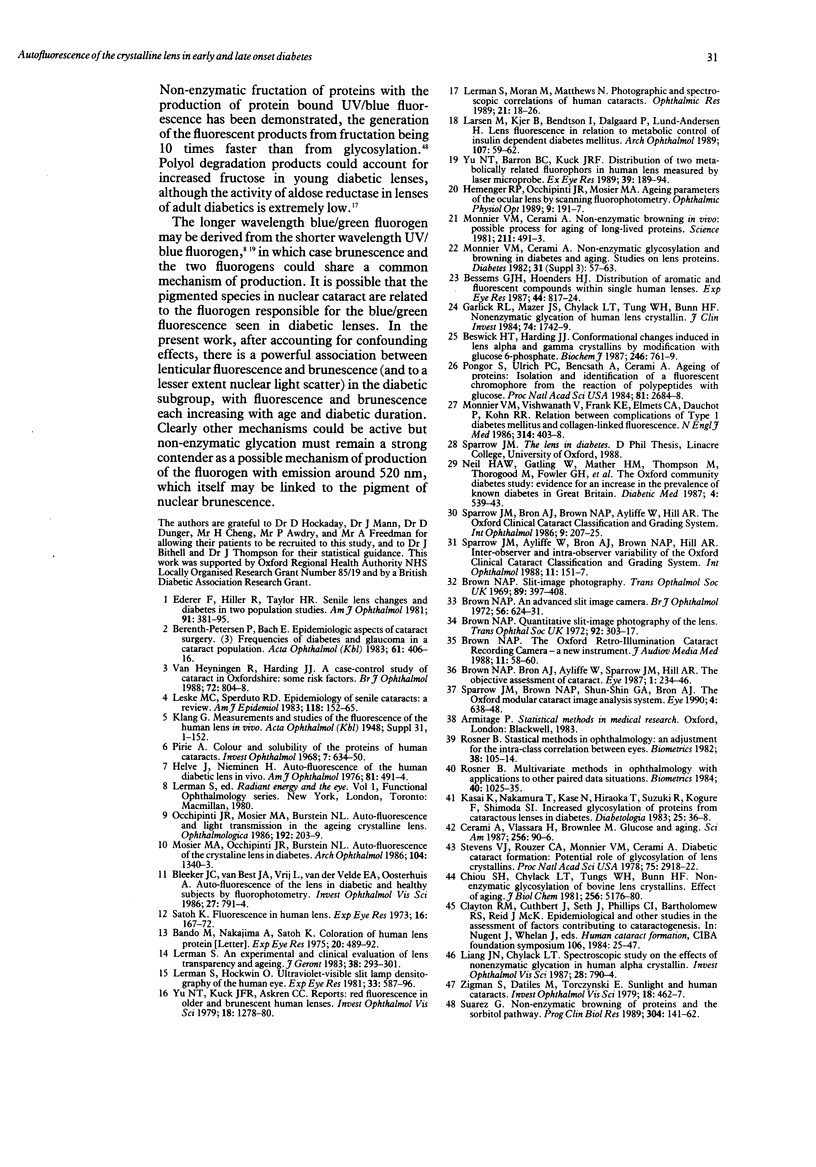
Images in this article
Selected References
These references are in PubMed. This may not be the complete list of references from this article.
- Bando M., Nakajima A., Satoh K. Coloration of human lens protein. Exp Eye Res. 1975 May;20(5):489–492. doi: 10.1016/0014-4835(75)90089-5. [DOI] [PubMed] [Google Scholar]
- Bernth-Petersen P., Bach E. Epidemiologic aspects of cataract surgery. III: Frequencies of diabetes and glaucoma in a cataract population. Acta Ophthalmol (Copenh) 1983 Jun;61(3):406–416. doi: 10.1111/j.1755-3768.1983.tb01439.x. [DOI] [PubMed] [Google Scholar]
- Bessems G. J., Hoenders H. J. Distribution of aromatic and fluorescent compounds within single human lenses. Exp Eye Res. 1987 Jun;44(6):817–824. doi: 10.1016/s0014-4835(87)80044-1. [DOI] [PubMed] [Google Scholar]
- Beswick H. T., Harding J. J. Conformational changes induced in lens alpha- and gamma-crystallins by modification with glucose 6-phosphate. Implications for cataract. Biochem J. 1987 Sep 15;246(3):761–769. doi: 10.1042/bj2460761. [DOI] [PMC free article] [PubMed] [Google Scholar]
- Bleeker J. C., van Best J. A., Vrij L., van der Velde E. A., Oosterhuis J. A. Autofluorescence of the lens in diabetic and healthy subjects by fluorophotometry. Invest Ophthalmol Vis Sci. 1986 May;27(5):791–794. [PubMed] [Google Scholar]
- Brown N. A., Bron A. J., Ayliffe W., Sparrow J., Hill A. R. The objective assessment of cataract. Eye (Lond) 1987;1(Pt 2):234–246. doi: 10.1038/eye.1987.43. [DOI] [PubMed] [Google Scholar]
- Brown N. A. The Oxford retro-illumination cataract recording camera--a new instrument. J Audiov Media Med. 1988 Apr;11(2):58–60. doi: 10.3109/17453058809051357. [DOI] [PubMed] [Google Scholar]
- Brown N. An advanced slit-image camera. Br J Ophthalmol. 1972 Aug;56(8):624–631. doi: 10.1136/bjo.56.8.624. [DOI] [PMC free article] [PubMed] [Google Scholar]
- Brown N. Quantitative slit-image photography of the lens. Trans Ophthalmol Soc U K. 1972;92:303–307. [PubMed] [Google Scholar]
- Brown N. Slit-image photography. Trans Ophthalmol Soc U K. 1970;89:397–408. [PubMed] [Google Scholar]
- Cerami A., Vlassara H., Brownlee M. Glucose and aging. Sci Am. 1987 May;256(5):90–96. doi: 10.1038/scientificamerican0587-90. [DOI] [PubMed] [Google Scholar]
- Clayton R. M., Cuthbert J., Seth J., Phillips C. I., Bartholomew R. S., Reid J. M. Epidemiological and other studies in the assessment of factors contributing to cataractogenesis. Ciba Found Symp. 1984;106:25–47. doi: 10.1002/9780470720875.ch3. [DOI] [PubMed] [Google Scholar]
- Ederer F., Hiller R., Taylor H. R. Senile lens changes and diabetes in two population studies. Am J Ophthalmol. 1981 Mar;91(3):381–395. doi: 10.1016/0002-9394(81)90293-2. [DOI] [PubMed] [Google Scholar]
- Garlick R. L., Mazer J. S., Chylack L. T., Jr, Tung W. H., Bunn H. F. Nonenzymatic glycation of human lens crystallin. Effect of aging and diabetes mellitus. J Clin Invest. 1984 Nov;74(5):1742–1749. doi: 10.1172/JCI111592. [DOI] [PMC free article] [PubMed] [Google Scholar]
- Hemenger R. P., Occhipinti J. R., Mosier M. A. Ageing parameters of the ocular lens by scanning fluorophotometry. Ophthalmic Physiol Opt. 1989 Apr;9(2):191–197. doi: 10.1111/j.1475-1313.1989.tb00841.x. [DOI] [PubMed] [Google Scholar]
- Kasai K., Nakamura T., Kase N., Hiraoka T., Suzuki R., Kogure F., Shimoda S. I. Increased glycosylation of proteins from cataractous lenses in diabetes. Diabetologia. 1983 Jul;25(1):36–38. doi: 10.1007/BF00251894. [DOI] [PubMed] [Google Scholar]
- Larsen M., Kjer B., Bendtson I., Dalgaard P., Lund-Andersen H. Lens fluorescence in relation to metabolic control of insulin-dependent diabetes mellitus. Arch Ophthalmol. 1989 Jan;107(1):59–62. doi: 10.1001/archopht.1989.01070010061028. [DOI] [PubMed] [Google Scholar]
- Lerman S. An experimental and clinical evaluation of lens transparency and aging. J Gerontol. 1983 May;38(3):293–301. doi: 10.1093/geronj/38.3.293. [DOI] [PubMed] [Google Scholar]
- Lerman S., Hockwin O. Ultraviolet-visible slit lamp densitography of the human eye. Exp Eye Res. 1981 Dec;33(6):587–596. doi: 10.1016/s0014-4835(81)80098-x. [DOI] [PubMed] [Google Scholar]
- Lerman S., Moran M., Matthews N. Photographic and spectroscopic correlations of human cataracts. Ophthalmic Res. 1989;21(1):18–26. doi: 10.1159/000266762. [DOI] [PubMed] [Google Scholar]
- Leske M. C., Sperduto R. D. The epidemiology of senile cataracts: a review. Am J Epidemiol. 1983 Aug;118(2):152–165. doi: 10.1093/oxfordjournals.aje.a113625. [DOI] [PubMed] [Google Scholar]
- Liang J. N., Chylack L. T., Jr Spectroscopic study on the effects of nonenzymatic glycation in human alpha-crystallin. Invest Ophthalmol Vis Sci. 1987 May;28(5):790–794. [PubMed] [Google Scholar]
- Monnier V. M., Cerami A. Nonenzymatic browning in vivo: possible process for aging of long-lived proteins. Science. 1981 Jan 30;211(4481):491–493. doi: 10.1126/science.6779377. [DOI] [PubMed] [Google Scholar]
- Monnier V. M., Vishwanath V., Frank K. E., Elmets C. A., Dauchot P., Kohn R. R. Relation between complications of type I diabetes mellitus and collagen-linked fluorescence. N Engl J Med. 1986 Feb 13;314(7):403–408. doi: 10.1056/NEJM198602133140702. [DOI] [PubMed] [Google Scholar]
- Mosier M. A., Occhipinti J. R., Burstein N. L. Autofluorescence of the crystalline lens in diabetes. Arch Ophthalmol. 1986 Sep;104(9):1340–1343. doi: 10.1001/archopht.1986.01050210094032. [DOI] [PubMed] [Google Scholar]
- Neil H. A., Gatling W., Mather H. M., Thompson A. V., Thorogood M., Fowler G. H., Hill R. D., Mann J. I. The Oxford Community Diabetes Study: evidence for an increase in the prevalence of known diabetes in Great Britain. Diabet Med. 1987 Nov-Dec;4(6):539–543. doi: 10.1111/j.1464-5491.1987.tb00926.x. [DOI] [PubMed] [Google Scholar]
- Occhipinti J. R., Mosier M. A., Burstein N. L. Autofluorescence and light transmission in the aging crystalline lens. Ophthalmologica. 1986;192(4):203–209. doi: 10.1159/000309647. [DOI] [PubMed] [Google Scholar]
- Pirie A. Color and solubility of the proteins of human cataracts. Invest Ophthalmol. 1968 Dec;7(6):634–650. [PubMed] [Google Scholar]
- Pongor S., Ulrich P. C., Bencsath F. A., Cerami A. Aging of proteins: isolation and identification of a fluorescent chromophore from the reaction of polypeptides with glucose. Proc Natl Acad Sci U S A. 1984 May;81(9):2684–2688. doi: 10.1073/pnas.81.9.2684. [DOI] [PMC free article] [PubMed] [Google Scholar]
- Rosner B. Multivariate methods in ophthalmology with application to other paired-data situations. Biometrics. 1984 Dec;40(4):1025–1035. [PubMed] [Google Scholar]
- Rosner B. Statistical methods in ophthalmology: an adjustment for the intraclass correlation between eyes. Biometrics. 1982 Mar;38(1):105–114. [PubMed] [Google Scholar]
- Sato K., Bando M., Nakajima A. Fluorescence in human lens. Exp Eye Res. 1973 Jun;16(2):167–172. doi: 10.1016/0014-4835(73)90311-4. [DOI] [PubMed] [Google Scholar]
- Sparrow J. M., Bron A. J., Brown N. A., Ayliffe W., Hill A. R. The Oxford Clinical Cataract Classification and Grading System. Int Ophthalmol. 1986 Dec;9(4):207–225. doi: 10.1007/BF00137534. [DOI] [PubMed] [Google Scholar]
- Sparrow J. M., Brown N. A., Shun-Shin G. A., Bron A. J. The Oxford modular cataract image analysis system. Eye (Lond) 1990;4(Pt 4):638–648. doi: 10.1038/eye.1990.89. [DOI] [PubMed] [Google Scholar]
- Stevens V. J., Rouzer C. A., Monnier V. M., Cerami A. Diabetic cataract formation: potential role of glycosylation of lens crystallins. Proc Natl Acad Sci U S A. 1978 Jun;75(6):2918–2922. doi: 10.1073/pnas.75.6.2918. [DOI] [PMC free article] [PubMed] [Google Scholar]
- Suarez G. Nonenzymatic browning of proteins and the sorbitol pathway. Prog Clin Biol Res. 1989;304:141–162. [PubMed] [Google Scholar]
- Yu N. T., Barron B. C., Kuck J. F., Jr Distribution of two metabolically related fluorophors in human lens measured by laser microprobe. Exp Eye Res. 1989 Aug;49(2):189–194. doi: 10.1016/0014-4835(89)90089-4. [DOI] [PubMed] [Google Scholar]
- Yu N. T., Kuck J. F., Jr, Askren C. C. Red fluorescence in older and brunescent human lenses. Invest Ophthalmol Vis Sci. 1979 Dec;18(12):1278–1280. [PubMed] [Google Scholar]
- Zigman S., Datiles M., Torczynski E. Sunlight and human cataracts. Invest Ophthalmol Vis Sci. 1979 May;18(5):462–467. [PubMed] [Google Scholar]
- van Heyningen R., Harding J. J. A case-control study of cataract in Oxfordshire: some risk factors. Br J Ophthalmol. 1988 Nov;72(11):804–808. doi: 10.1136/bjo.72.11.804. [DOI] [PMC free article] [PubMed] [Google Scholar]



